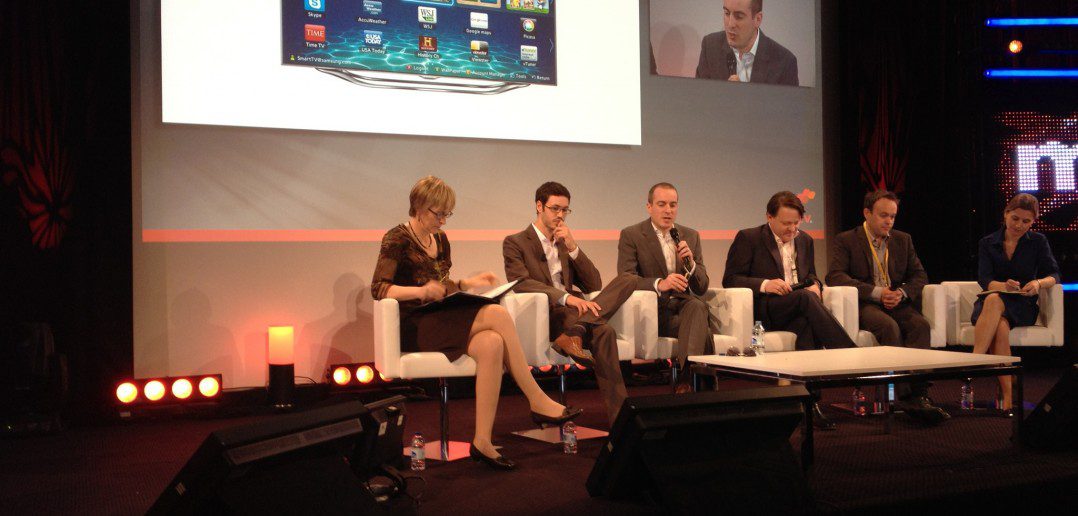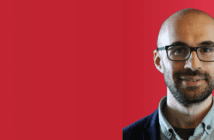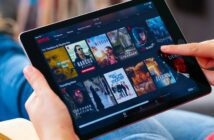[youtube]eOYKacvoE6o[/youtube]
The second session at MIPTV today saw some of the key players in connected devices explain what they’re doing and how they see the market. The session was moderated by journalist Kate Bulkley.
Daniel Saunders, director of content services at Samsung Electronics Europe, was first to speak, focusing on the company’s Smart TV business.
“What it’s important to understand is although the look and feel of the platform is evolving year on year, the architecture that supports that technology is the same,” he said. The result being what he described as a “substantial base” of consumers, helped by the fact that one in four TV sets sold in Europe are made by Samsung.
Saunders also gave some stats: “We’re talking about 20m apps downloaded to Samsung Smart TVs globally by the end of January this year,” he added, while stressing that this has been growing rapidly. “We are experiencing exponential engagement.”
The emphasis for Smart TV apps has been on video, whether video-on-demand apps from services, or apps from broadcasters. But it doesn’t allow third-party services to overlay the linear broadcast stream, unless they’re the broadcaster itself on their own channel.
“These types of channel-bound services and the non-linear catch-up services are the ones that create the most engagement,” he said.
Next up, Peter Mercier, senior director of content acquisition and strategy at Microsoft UK, who talked about what the company is doing with its Xbox Live service. “Xbox Live is a business that’s innovating around content and experiences,” he said.
Those innovations include multiplayer gaming in 2002, a video marketplace in 2006, Netflix’s app in 2008, live TV with BSkyB and Canal+ in 2009, and then the Kinect voice and gesture controller in 2011. Microsoft has sold 66 million Xbox consoles, and 18 million Kinect devices, while Xbox Live has more than 40 million people in more than 30 countries.
“Most of you will assume it’s a games console and it’s really about gaming,” he said. “Last year, for the first time, we saw the usage of entertainment content on the console exceed multiplayer gaming.”
Xbox Live Gold members are using Xbox Live for around 84 hours a month, up 30% year-on-year. And the company claims that its Zune video marketplace is the second largest transactional video service in the world, after Apple’s iTunes.
So what’s next for Xbox? More content, more markets and more devices, while also working on “transformative interactive experiences” with partners like Sesame Street and NatGeo using Kinect – see this blog post for more on the former.
Saunders said that “something like Xbox is a very good benchmark” for Samsung. “Now we’re moving into a world where we begin to have a relationship with the people buying our TV sets on a daily basis.” He declined to give a figure for the number of Samsung Smart TVs sold so far, though.
Next to speak was Christian Bombrun, deputy managing director at M6 Web in France, a division of broadcaster M6.
It offers a suite of connected TV services, including catch-up TV, a separate video-on-demand service for content outside that seven-day catch-up window, and social TV. The company’s service is available on eight million TV screens in France, and three million tablets and smartphones.
It generated 500 million video views in 2011, with 50% of those on TV screens, 35% on PCs and 15% on tablets and smartphones. M6 also launched a free TV app on Xbox 360 in France, targeting 2.7m of the console’s install base there.
It offers all the services listed above, and works with the Kinect controller. “The download and usage figures for the M6 app are very high, and we are very happy about it,” he said.
The French network also announced exclusively at MIPTV that it is about to launch a service for Samsung’s connected TV sets too, as well as Sony’s Bravia platform.
Bombrun said that M6 sees challenges, including the fact that a connected TV service’s success depends on its user interface – he praised Xbox Live on these grounds – and noted that piracy remains a concern as connected TV platforms open up. He also warned that there need to be industry standards for measuring and monetising these services.
Finally, Emma Lloyd, director of emerging products at BSkyB in the UK spoke, saying the industry needs to “think about understanding what’s happening in the living room”.
And that is? “More TV viewing than there has ever been. Four hours and two minutes of TV viewing every single day, and most of that is still linear viewing.” Even in houses with the Sky+ PVR, only 18% of viewing is time-shifted. “Linear TV is still in very rude health.”
Sky has 10.3 million UK customers, and eight million of those have the Sky+ PVR, with more than one million using the broadcaster’s AnyTime+ on-demand service for movies and TV shows.
Lloyd said Sky is also keenly focused on the tablets, smartphones and consoles opportunities. Its Sky Go service has been “an amazing success” in the UK, enabling customers to watch on their phones and iPads, Xbox consoles and PCs, for free as part of their subscriptions.
“We get over 10 million live views to that a week, and many millions more on-demand views to that service. We have over five million registered devices, and three million registered households. Already in a third of Sky households this service is being used, and that’s in just eight months.”
Around 40% of Sky Go viewing is on phones and tablets, a third is on computers and a quarter is on games consoles. In its first week on Android, it got five million live views, alone, according to Lloyd.
BSkyB is also working on second-screen content in its iPad TV guide app, while also working hard on its Sky News app to deliver video and news content. But the big news recently was the announcement of Now TV, which will deliver Sky’s content to people who don’t already have a satellite dish at home.
Saunders said that there remains a challenge in getting “solid, quantifiable numbers” on how people are interacting with this new breed of services on an industry-wide basis.
Production company All3Media launched its own connected TV app in March this year, going direct to consumers. How disruptive will this be if more producers start doing it, cutting out the broadcaster middlemen?
“From our perspective, we’re trying to drive engagement with the Xbox Live audience regardless of who the supplier of content is,” said Mercier. “We typically see the bulk of activity through brands that people know and trust… that’s Sky, that’s M6, that’s the BBC,” he explained.
However, Microsoft is welcoming producers who want to work with it. “To us, that’s great, that’s innovative from them in particular, and we see others getting on these platforms.”
Bombrun noted that connected TV does open opportunities for producers to distribute their content – along with services like YouTube and DailyMotion. But he said it’s not a big threat for broadcasters just yet. “Maybe we are not cautious enough, but we don’t expect the fragmentation to be that big… We don’t think that it will endanger our audience, both linear and nonlinear… We are not worried.”
The panel talked about Apple, and commercial deals. “It’s fair to say that you shouldn’t treat all consumer electronics the same way. There are variations, there are some importantly subtle differences,” said Saunders. “It’s important that this works for everybody.”




